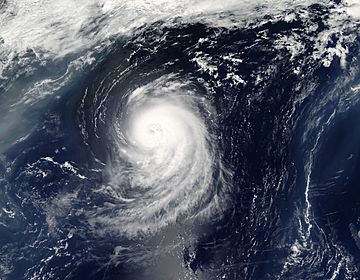Hurricane Irene (2005) facts for kids
| Category 2 hurricane (SSHWS/NWS) | |

Hurricane Irene on August 15, 3 days before dissipating
|
|
| Formed | August 4, 2005 |
|---|---|
| Dissipated | August 18, 2005 |
| Highest winds | 1-minute sustained: 105 mph (165 km/h) |
| Lowest pressure | 970 mbar (hPa); 28.64 inHg |
| Fatalities | 1 |
| Damage | None |
| Areas affected | East Coast of the United States |
| Part of the 2005 Atlantic hurricane season | |
Hurricane Irene was a powerful storm that formed in the Atlantic Ocean in 2005. It was part of the 2005 Atlantic hurricane season. This storm traveled across the ocean for many days. It eventually lost its strength far from land. Irene lasted for 14 days as a tropical system. This was the longest time for any storm during the 2005 hurricane season.
Contents
Hurricane Irene: A Long Journey
Irene's Journey Across the Atlantic
Hurricane Irene began near the Cape Verde Islands on August 4, 2005. These islands are off the coast of Africa. The storm then moved west across the vast Atlantic Ocean. After a while, it turned north. It passed near Bermuda, an island in the Atlantic. Finally, Irene weakened and lost its storm name southeast of Newfoundland, Canada.
A Tricky Storm to Predict
Irene was a difficult storm for weather experts to forecast. On August 10, it almost disappeared. But then, it surprisingly gained back its strength. Irene became a Category 2 hurricane on August 16. This means its winds were very strong.
Impact and Warnings
Because Hurricane Irene stayed far away from land, no special storm warnings were needed. The storm also did not cause any major damage to buildings or property. However, it did create very strong waves. These waves reached the East Coast of the United States.
Sadly, the strong waves caused one serious accident. A 16-year-old boy drowned near Long Beach, New York. He was caught in a powerful rip current. These currents can pull swimmers away from the shore. At one beach, lifeguards had to rescue more than 100 people from the rough waters. The name "Irene" was later used again for another hurricane in 2011.
Related pages
|
Tropical cyclones of the 2005 Atlantic hurricane season |
|||||||||||||||||||||||||||||||||||||||||||||||
|
|
||||||||||||||||||||||||||||||||||||||||||||||
|
|
|||||||||||||||||||||||||||||||||||||||||||||||
Images for kids
See also
 In Spanish: Huracán Irene (2005) para niños
In Spanish: Huracán Irene (2005) para niños


